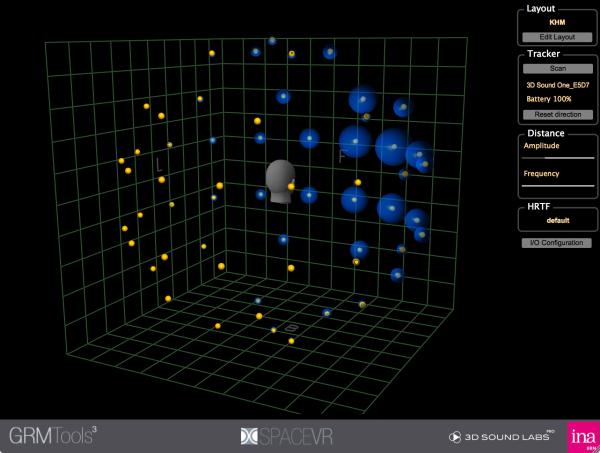Spacemaster Mac OS
See more @ The follow up to the X-33 is the Spacemaster Z-33 (technically part of the Speedmaster collection). It has a special t.
New for 2019, Spaces now includes the new module Spaces3D which lets you move your source in three dimensions.
Get unprecedented control of the sound field with total automation of positions and trajectories as well as being able to spatialize your signal by up to 4 independent frequency bands or even enables the generation of up to 100 grains of spatial positions you can make your sounds hop to randomly.
GRM Tools Spaces is a powerful tool that enables the positioning and movement of a multichannel source (from 1 to 32 channels) in a multichannel space (from 2 (stereo) to 32 channels). It has a user friendly graphic interface showing the location and intensity of the sources as they move through the multichannel project.
Spaces also includes three other exciting modules that expand the possibilities of the positioning of your sources in a sound field, SpaceGrain, SpaceFilter and Spaces3D.
Spaces3D enables you to move around a source of multichannel sound (from 1 to 64 channels) in a multichannel space (from 1 to 64 channels) in three dimensions. The movement can be free, random, or can follow trajectories predetermined by the user.
SpaceGrain enables the generation of up to 100 'grains' and their placing in a multi-channel sound space.. This gives you 100 points where your sounds are randomly assigned from point to point. Each grain provides a mono site for the sources to be heard. The input channels (up to 8) are randomly allocated to the grains. You can add delay and feedback to create extremely creative effects.
SpaceFilter is used to spatialize the signal by using 4 independent frequency bands that you can set. The input signal spectrum is split into 4 independent bands where you choose the center frequency and the bandwidth to which you can apply delay and feedback. The output of each filter can be positioned individually in a multi-channel space (up to 32 channels can be used). You can separate different frequency elements of your source and make different resonances fly between speakers according to the tempo if you want. Your imagination is the only limit as to what you can make happen with Spacefilter.
Spaces with all its adjustments of the placement, delay, and resonances opens creative possibilities for adding effects that have never been heard before. For post-production mixers it provides a tool to fine-tune their positioning of sources and to accentuate the movements of the sounds which are following the images. It is a new powerful set of tools that can make sounds fly behind you, in front of you, up and down, and of course from side to side in any way you want with total control.
Two other modules, SpaceMaster and SpaceVR are now available as standalone freeware.
SpaceMaster enables you to identify and calibrate different multichannel output channels (from 1 to 64) and to position the input channels in the output space.
Developed in collaboration with 3D Sound Labs, SpaceVR generates a stereo binaural output from a multichannel input (from 1 to 64 channels) by using head-related transfer functions (HRTF) from 3D Sound Labs. The orientation and position of the listener can be modified.

Today is the 20th anniversary of the release of Mac OS X. I wrote a bit about it in my Macworld column this week, and also put together a little Mac OS X timeline.
I’ve written a lot about Mac OS X over the years. Compiling that timeline reminded me of that. I was a features editor at Macworld when Apple began shipping OS X precursors, and so I edited most of our early coverage. Beginning with Mac OS X 10.1, I wrote most of Macworld’s big feature stories covering each release.
- Choose Apple menu About This Mac, then click Storage. Each segment of the bar is an estimate of the storage space used by a category of files. Move your pointer over each segment for more detail. Click the Manage button to open the Storage Management window, pictured below.
- Mac OS X, in turn, evolved in part from Steve Jobs' NeXT operating system—which had recently been acquired by Apple—and its launch was the harbinger of the second Jobs era at Apple.
- SpaceMaster Mode (or SM Mode for short) offer access to many world-building functions within the game itself, and has access to detailed information for each race. With SpaceMaster mode activated, you can give yourself free stuff, take it away, alter planets, create and delete star systems, teleport ships, manipulate your officers, and many other tasks.
- There are a lot of great mice out there, but picking the best one for you and your Mac can be a challenge. It very much depends on what you want to do with it — after all, some are great for.
I’ve lived in the same house since 1999, so I have spent many springs and summers sitting out in my yard under our redwood tree writing and editing articles about Mac OS X, OS X, and now macOS.
Mac Os Mojave
How many? This many:
- OS X Prehistory (compiled by me from multiple Macworld features)
Spacemaster Mac Os Download
Wow, that’s a lot of operating-system releases. Here’s to the next uncountable number of them.
(While I wrote shorter reviews for Macworld, John Siracusa was always reviewing OS X at length for Ars Technica. Here’s a list of all his reviews.)
Spacemaster Mac Os X
If you appreciate articles like this one, support us by becoming a Six Colors subscriber. Subscribers get access to an exclusive podcast, members-only stories, and a special community.